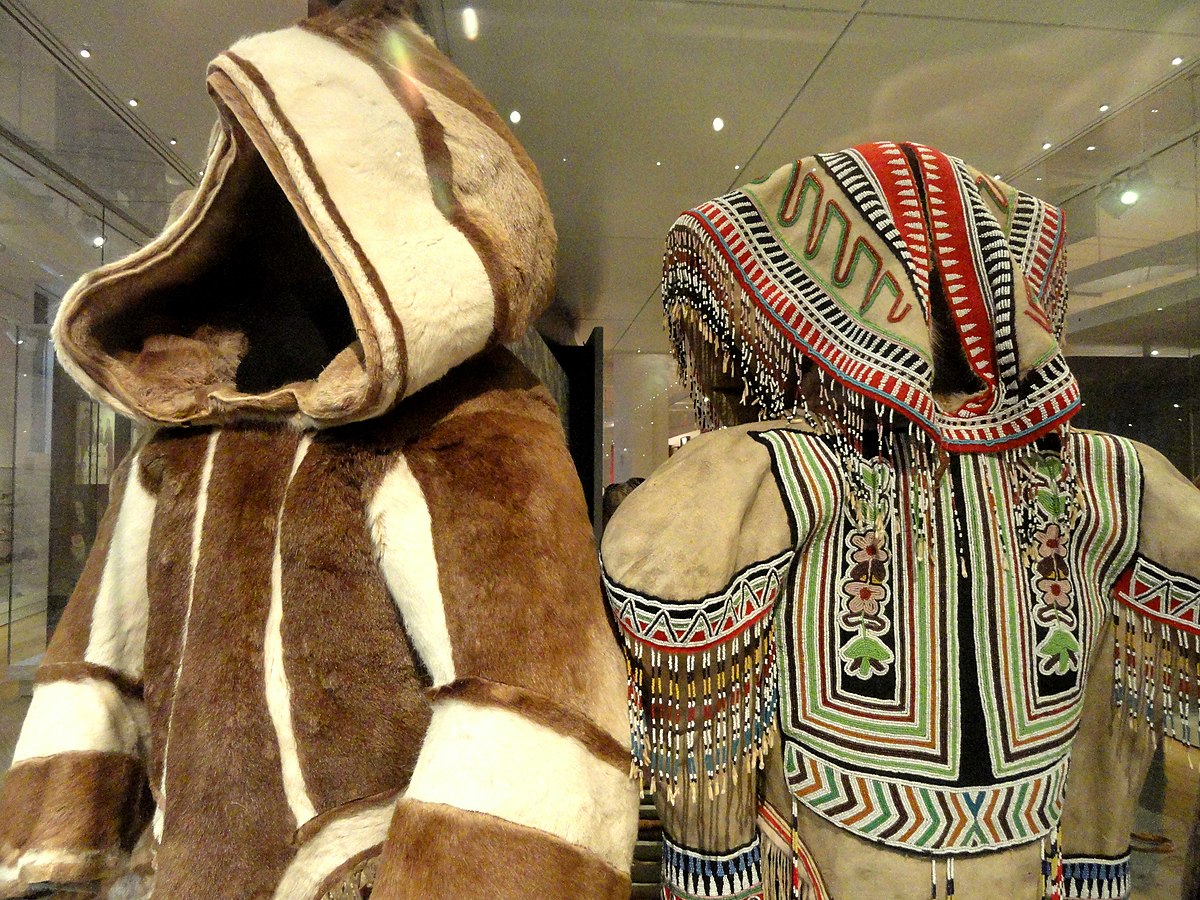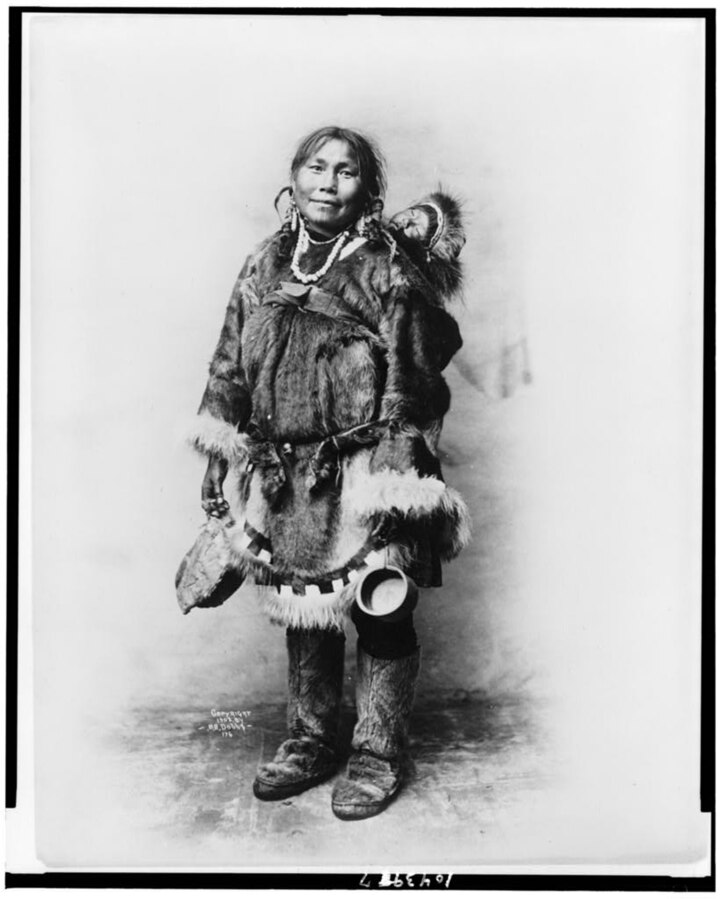The Amauti, a traditional Inuit garment, embodies the practicality and cultural richness of the Arctic people. This unique piece of clothing is not just a testament to the ingenuity of the Inuit in adapting to their harsh environment, but it also serves a very special purpose. Designed for mothers, the Amauti is a fascinating example of how clothing can be tailored to fit the needs of a community, specifically for baby-carrying in one of the world’s most extreme climates.
This article discusses the Amauti, exploring its history, design, and the role it plays in the daily lives of the Inuit people. As we uncover the layers of this remarkable garment, we gain insights not only into a practical item of clothing but also into the rich tapestry of Inuit culture and family life.
Historical Background of the Amauti
The Amauti traces its origins back centuries, deeply rooted in the Inuit culture of the Arctic regions. Originally designed to withstand the harsh Arctic climate, it has evolved while retaining its fundamental purpose and design. The traditional Amauti was typically made from animal skins, such as caribou or seal, chosen for their warmth and durability. Over time, while the basic design has remained consistent, the materials and decorative elements have seen variations, reflecting changes in availability and cultural influences.
Cultural Significance and Symbolism
In Inuit culture, the Amauti is more than just a garment; it represents a deep connection between mother and child. The design, which includes a large hood or pouch at the back, is specifically tailored for carrying a child, keeping them warm and protected against the biting cold. This unique feature is a symbol of motherhood and nurturing in the Inuit society.
The Amauti is often passed down through generations, becoming a symbol of family heritage and continuity. The making of an Amauti is also a communal activity, often involving the older women of the community, thereby making it a significant cultural practice that strengthens community bonds.
Role in Inuit Stories and Folklore
The Amauti features prominently in many Inuit stories and folklore, often symbolizing the themes of survival, motherhood, and the wisdom of ancestors. These stories reflect the essential role of the Amauti in everyday life and underscore its importance not just as a physical garment but as a key element in the cultural and spiritual identity of the Inuit people. The tales and legends passed down through generations highlight the Amauti’s role in protecting and nurturing life in one of the harshest environments on Earth.
Design and Functionality of the Amauti
The Amauti is ingeniously designed to cater to the specific needs of Inuit mothers and their babies. It stands out for its practicality, warmth, and adaptability to the Arctic environment. The design of the Amauti reflects a deep understanding of the local climate and the lifestyle needs of the Inuit people.
Key Features and Construction
- Material: Traditionally made from animal skins like caribou or seal, modern Amautis may also use contemporary, warm fabrics. These materials are chosen for their ability to provide insulation and withstand Arctic temperatures.
- Hood/Pouch: The most distinctive feature is the large hood or pouch at the back. It is spacious enough to comfortably hold a baby, allowing skin-to-skin contact and sharing body heat.
- Shape and Fit: The Amauti is roomy and allows for easy movement. It is typically longer in length to provide extra warmth and protection against the elements.
- Adornments: While functional, Amautis can also be adorned with intricate designs and patterns, reflecting regional styles and personal tastes. These decorations often hold cultural significance.
Functionality in the Arctic Environment
- Warmth and Protection: The primary function is to keep both the mother and child warm in extremely cold temperatures. The design ensures no cold air enters the pouch, and the snug fit of the hood around the baby provides additional insulation.
- Ease of Baby-Carrying: The design allows for hands-free carrying, which is essential for mothers who need to perform other tasks while ensuring their child’s safety and warmth.
- Adaptability: The Amauti is versatile and can be adapted to different weather conditions and activities, making it an essential garment for everyday life in the Arctic.
Modern Adaptations
While the traditional design remains popular, modern adaptations have seen the introduction of new materials and styles. These adaptations make the Amauti more accessible to a wider audience while still retaining its cultural significance and functionality.
Cultural Significance of the Amauti
The Amauti is much more than a garment in Inuit culture; it is a profound symbol of motherhood, community, and survival. It represents the nurturing relationship between a mother and her child and is integral to the family structure within Inuit communities. The act of carrying a child in an Amauti is a physical manifestation of love and protection, embodying the deep-rooted values of family and community care in the Arctic.
Craftsmanship and Community Bonding
The process of creating an Amauti is steeped in tradition and is often a communal activity involving experienced women in the community. It is not only a time to craft a necessary garment but also an opportunity for sharing stories, wisdom, and skills from one generation to the next.
The creation of an Amauti is an avenue for passing down cultural knowledge and practices. It involves teaching young women various skills like sewing, choosing the right materials, and understanding the symbolic meanings of designs and patterns.
Preservation of Inuit Culture
The Amauti is a tangible representation of Inuit identity and heritage. Its continued use and the passing of knowledge associated with it play a crucial role in preserving the unique cultural identity of the Inuit people. Wearing an Amauti is a source of pride and a way to maintain a connection to ancestral traditions, especially in a modern world where many indigenous practices are becoming less common.
The Amauti has also become a means of cultural exchange, introducing others to Inuit traditions and perspectives. Its uniqueness sparks interest and dialogue, helping to spread awareness and understanding of Inuit culture globally.
The Amauti in Contemporary Times
While the Amauti remains a symbol of traditional Inuit culture, it has also adapted to modern times, balancing the preservation of tradition with contemporary influences. This adaptability underscores the resilience and dynamic nature of Inuit culture as it continues to thrive and evolve in the modern world.
Contemporary Use and Adaptations
The Amauti has successfully transitioned into modern Inuit life, maintaining its cultural significance while adapting to new contexts and materials. This transition is a testament to the resilience and adaptability of Inuit culture in a rapidly changing world.
Modern Materials and Styles
Contemporary Amautis are often made with modern materials like synthetic fibers, which are easier to obtain and maintain than traditional animal skins. These materials can offer similar levels of warmth and durability. Today’s Amautis may incorporate more varied designs and colors, catering to personal tastes while retaining the traditional functionality. This variety allows for a blend of traditional and contemporary fashion.
Use in Urban Settings
As Inuit people and culture interact more with urban environments, the Amauti have found a place in cities and towns. It remains a practical and cherished option for baby-carrying, even outside of the traditional Arctic setting. In urban contexts, the Amauti serves as a cultural emblem for Inuit individuals, providing a sense of identity and connection to their roots.
Promoting Inuit Culture
The presence of the Amauti in diverse settings raises awareness and interest in Inuit culture. It acts as a conversation starter and an educational tool, sharing the richness of Inuit traditions with a broader audience. The Amauti has also caught the attention of the fashion world, with designers drawing inspiration from its unique design. This interest helps to promote and celebrate Inuit craftsmanship and aesthetic sensibilities.
Inuit Empowerment and Economic Opportunity
The production of Amautis, especially by Inuit artisans, offers economic opportunities and empowers communities. It supports the local economy and encourages the continuation of traditional crafts. The internet and social media have enabled Inuit artisans to reach a global market, expanding the audience for traditional Amautis and modern adaptations. This global reach not only provides economic benefits but also fosters a greater understanding and appreciation of Inuit culture worldwide.
The contemporary use and adaptations of the Amauti demonstrate its enduring relevance and the dynamic nature of Inuit culture. It remains a vital link to the past, a practical garment for the present, and a symbol of cultural pride and resilience moving into the future.
Challenges and Preservation
The tradition of the Amauti, like many indigenous practices, faces challenges in the modern era. These challenges range from the loss of traditional skills to the impact of global influences and the difficulty in sourcing traditional materials.
- The Decline in Traditional Skills: One of the primary challenges is the declining number of artisans skilled in making traditional Amautis. As younger generations move towards urbanized lifestyles, there’s a risk of these skills not being passed down.
- Material Availability: The traditional materials used in Amauti making, such as caribou or seal skin, are becoming harder to obtain due to various factors, including climate change and regulatory restrictions on hunting.
- Cultural Dilution: Globalization and the influx of modern lifestyle choices can lead to a dilution of cultural significance, with traditional practices being overlooked or undervalued by younger generations.
Efforts Toward Preservation
Despite these challenges, there are concerted efforts to preserve the Amauti tradition, ensuring that this unique aspect of Inuit culture continues to thrive.
- Cultural Workshops and Education: Many communities and organizations are hosting workshops to teach the art of making Amautis, ensuring the transfer of knowledge to younger generations. These workshops often incorporate elements of Inuit history and culture, providing a holistic understanding of the garment’s significance.
- Support from Cultural Institutions: Museums, cultural centers, and educational institutions play a vital role in preserving and showcasing the Amauti. Exhibitions and educational programs help in raising awareness and appreciation among both Inuit and non-Inuit populations.
- Promotion of Inuit Artisans: Supporting Inuit artisans by promoting and purchasing their work helps keep the tradition alive. This not only provides economic benefits but also encourages the continuation of traditional craftsmanship.
- Documenting and Researching: Efforts by researchers and historians to document the history and techniques of Amauti contribute to its preservation. This documentation serves as a valuable resource for future generations.
Role of Communities and Individuals
The role of both Inuit and non-Inuit communities and individuals is crucial in the preservation of the Amauti tradition.
- Community Engagement: Active participation in cultural practices and events by community members helps keep the tradition alive and relevant.
- Global Awareness and Support: Interest and support from the global community, including awareness campaigns and cultural exchange programs, can aid in the preservation efforts.
- Personal Responsibility: Individuals can contribute by learning about, respecting, and promoting Inuit culture and traditions. This can include educating others, supporting Inuit artists, or participating in cultural events.
While there are significant challenges in preserving the Amauti tradition, a combined effort from communities, cultural institutions, and individuals can ensure that this unique aspect of Inuit heritage continues to be a vibrant and living practice.
Conclusion
In wrapping up our exploration of the Amauti, it’s clear that this traditional Inuit garment is more than just a piece of clothing. It’s a rich symbol of culture, a practical tool for parenting, and a testament to the resilience of the Inuit people. The Amauti beautifully blends the past with the present, showing us how traditions can adapt and thrive even in a changing world.
By understanding and appreciating the Amauti, we gain insights not only into Inuit culture but also into the broader themes of adaptation, community, and the enduring bonds between parent and child. As we move forward, it’s important to support and preserve such cultural treasures, for they offer valuable lessons and connections to our shared human heritage.


